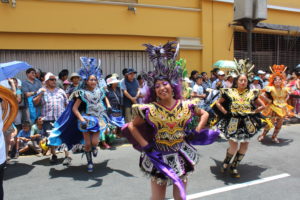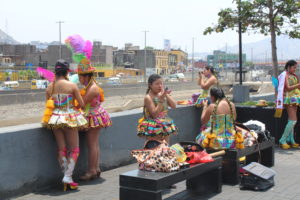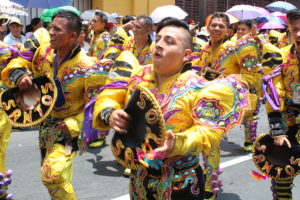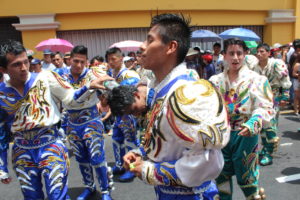Negotiating with the gods
Early in the morning, behind the Plaza de Armas, in the Parque Chabuca Grande, groups of girls, helped by their friends and mothers, pin on their hats and wrap threads in their hair, whilst the men slather on sun block, and adjust their boot bells.
Each February in Puno, high in the Peruvian Andes, 100,000 dancers, men and women, celebrate the Festival of the Virgen of Candelaria. The people come from the town itself and from communities all around. And in Lima too they gather at the same time: the people who now live on the mountainside settlements on the edges of the capital, the Pueblos Jovenes, new towns, who recognise, on this day, their belonging to the communities around the lake 20 hours journey to the South.
There are up to 80 groups here each composed of a hundred or two hundred dancers, with a band walking behind. The Morenadas (darkies) include slaves in black masks, with the Spanish overlords bearing whips; the Tinkus, have woven sashes round their waists, displaying birds, felines, serpents and geometrical patterns, their hats ringed with mirrors and hung with ribbons; Sikuris wear red pointed hats and play on the Andean flute; Diabaladas, the devils, have horned masks, great goggle eyes and long red hair. They combine elements of theatre, music and dance, and are at once social and religious, secular, Catholic and Andino.
A typical Caporale woman has puffed lace ruffled sleeves, red and gold thread in her twin plaits, thigh high gold boots, red and gold corset and petticoat, with silver padded shoulders and red and silver hat perched atop her head, red and gold and green and white ribbons hanging down, red lipstick, false eyelashes, red and gold eyeshadow, giant gold and silver tassels at the end of her braids.
Other Caporales might be in green and yellow, or blue and orange, the women always matching the colours with threads in their hair, the shading around their eyes.
The men have trousers and embroidered shirts with great puffed sleeves and padded shoulders, in blue and silver or black and gold. Some of the men have falcons or eagles embroidered on their trousers, or long-tailed pumas climbing up their outside legs. They carry cowboy hats, embroidered in silver, held outstretched in one hand as they dance.
Each member of a band has the same essential costumes but there are personal touches in the face make up, the ribbons and the sashes.
has the same essential costumes but there are personal touches in the face make up, the ribbons and the sashes.
Six months earlier I had seen groups rehearsing in a central park in Lima, with a sound system, a leader with a whistle, no costumes, just a hat, jeans and t-shirt. “We are from Puno,” they told me, “Puno, Bolivia.”
Most of the dancers are younger than 30 and some are teenagers. The youngest is a four year old, complete with a miniature embroidered waistcoat and sequinned hat to match that of his father.
Older men, and a few women, play in the band, a less demanding task, though it still needs strength to walk with a heavy drum or trumpet for five or six hours in the hot sun. Others pass amongst the dancers spraying them with a fine mist of water on their face and back.
Each dance group has up to 100 members – in Puno it cou ld be up to 1000. There are many dances, complex of footwork and teamwork. One or several leaders give instructions, holding up one or both hands, indicating with their fingers the next routine. They whistle, and the instructions are relayed through the group until everyone is clear. The band starts up and the dancers move together.
ld be up to 1000. There are many dances, complex of footwork and teamwork. One or several leaders give instructions, holding up one or both hands, indicating with their fingers the next routine. They whistle, and the instructions are relayed through the group until everyone is clear. The band starts up and the dancers move together.
Crowds line the streets on either side, applauding the end of each routine, more so if it has been executed with vigour, precision and feeling. And even in the early afternoon, when these groups have been on the street in temperatures of 30 degrees, here in Lima’s desert summer, the dancers are amazingly vital, smiling, bowing, running, jumping, whilst their foreheads hold beads of sweat and the gold glitter on their necks turns green.
The dancers had been dancing for two hours before they reached the judging area, in the Plaza de Armas, Lima’s main square, in front of the Catholic Cathedral, sited here on top of a historic pyramid.
Late in the afternoon, more than six hours after the parade began, some bands were dancing round the circuit for the second time. Other sat by the roadside, the heavier, bulkier pieces of costume, devil’s head-dresses and shoulder pads, besides them on the pavement, like medieval knights resting after a joust.
“We are asking Mamacita Candelaria to sort out all this corruption in Peru, the poverty, the floods and the landsl ides,” one of the dancers told me. “I am not tired.”
ides,” one of the dancers told me. “I am not tired.”
Some say these are Spanish traditions, and no doubt there are spanish influences, the musical instruments certainly, and the music too.
Some say the Jesuits taught them parables about the seven sins, and good and evil, represented in the dances.
But these activities in a public space display the moral values of honesty, teamwork, and commitment that hold a community together. The Spanish conquerors built no communities here. The performances are a celebration of working together, of bonding in a common endeavour. The Jesuit missions did not seek social consensus.
Norma Velasquez was born and brought up in Juliaca, but remembers little of the Candelaria in those days.
“When I was young I knew nothing about it. My society in J uliaca was composed of families from outside, we were not campesinos, we did not integrate with them. It was as if we were from Planet Earth, and they were from Mars. We had no curiosity. We had instead the certainty that their lives and culture meant nothing to us, they had no value.”
uliaca was composed of families from outside, we were not campesinos, we did not integrate with them. It was as if we were from Planet Earth, and they were from Mars. We had no curiosity. We had instead the certainty that their lives and culture meant nothing to us, they had no value.”
Norma spent her working life developing international markets for the alpaca herders, artesans and farmers in her home region, so she came in time to know the rhythm of the festival intimately.
“In Puno, the festival is not just for one day, but takes place over some weeks. It is as if people work all year to prepare for this event. It is a time to give their harvest to the gods.”
I wondered if February was a natural time to hold such a festival, when the alpaca have given birth in January, when the crops have been sown after the first rains.
“There is no time of year when they are not busy, there are always things to do in the fields. For them, Candelaria is part of their work, and they have to organise the season to make time for it.”
“The master of their farming schedule is the weather. Of course they make plans when the year begins in May, when they will plant the seed, and irrigate, and harvest. But the weather gives the orders. If they see a black cloud in the East, they have to harvest the potatoes, however small they may be, because if hail comes it will destroy the entire crop.”
“Candelaria is not a festival for them, is is not a diversion, it is an obligation. It is a time for the people to talk to their gods, to thank them for the past year, and to submit their requests for the year to come. They are negotiating an annual contract between the planet and human beings, and nothing could be more important than that.”
I was reminded of words of one of the Huichol people in Mexico, who make an annual pilgrimage 500 km to their historic homelands. “It is not easy for us”, he said,” non-Huichols have no idea how hard we work to insure that not only Huichol corn will grow, but your corn and other food as well. We Huichols were born to be the caretakers. The deals we strike with the gods are for the benefit of all, which is why we work so hard at it. The day we stop, will be the day that many on earth go hungry.”
Lima’s festivals such as Santa Rosa de Quives are stratified and controlled by religious institutions. A select body of up to 24 men, and only men, carry the effigy of the saint in ornate robes through the streets, whilst women, veiled, walk backwards  adoring the figure.
adoring the figure.
Candelaria, by contrast, is a public festival. Commitment to the group is what matters – to attend practice, to learn to work together. This could be a team-building exercise for a modern multinational, whereas Lima’s street processions of effigies draped in gold and silver are hierarchical and medieval.
For thousands of years Puneños have been passing on these lessons to the next generation, and for twenty years now, they have been bringing them to Lima. At considerable personal expense, and after months of practice, the peoples of Puno offer, to all who care to join, classes in inclusivity and community, in the values of a modern plural society. Is Lima listening?
Go forward to 35 Keeping it in the family
